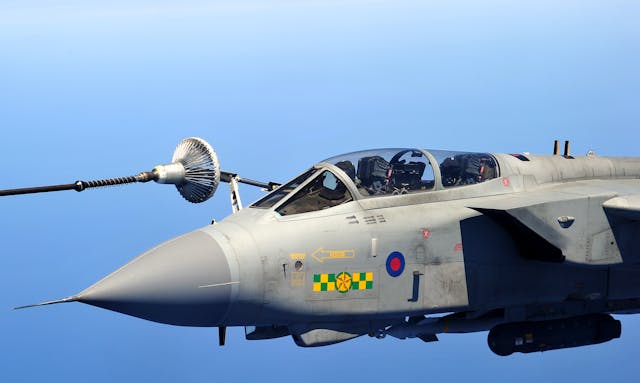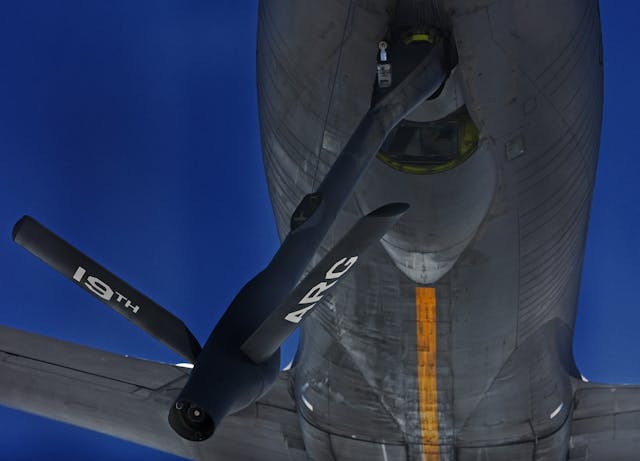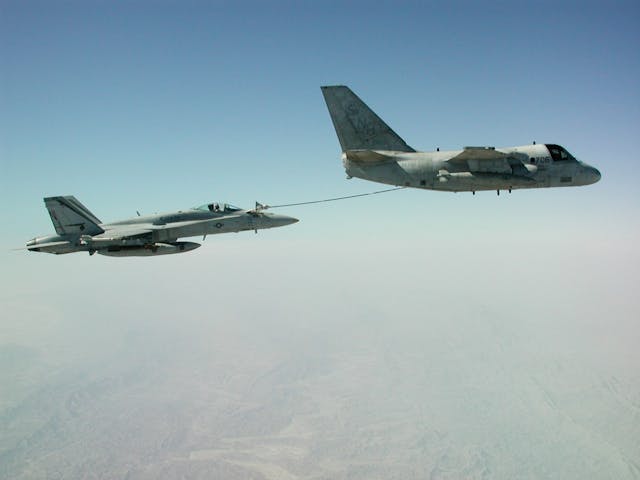On the 98th anniversary of aerial refueling, our tame fighter pilot breaks it down
I have a brother who once quit his job at a fast food joint by going through the drive-thru at the start of his shift and telling the order taker, “Yo, this is Steve. I quit!”
It’s interesting to talk to people about their jobs and how they got to where they are. I’m amazed that there are folks that want to be actuaries, or accountants, or aircraft maintainers, but I am grateful for them and the pride they take in their work. One job I don’t understand: wing walkers. I thought wing walking was long extinct, having gone the way of the laser disc. Turns out it’s still very much a thing. Crazily enough, there are people who climb onto the wing of a flying airplane and walk around, sometimes moving from one airborne airplane to another. I’m glad they enjoy it, but it’s not for me (nor is jumping out of perfectly good airplanes)! Wing walking has also been used to refuel planes. More on that in a moment.
Refueling has been a topic of much interest to a lot of people lately. I’ll occasionally read an article bashing electric cars and the bemoaning of how long it takes to recharge them and how impractical they are on road trips. I love road trips as much as anyone here (personal single-day driving record is just shy of 1,100 miles) and the freedom of being able to depart whenever I want for whatever destination I desire is glorious. The entirety of my electric car experience is riding in and then driving my dad’s Hyundai Kona for about 10 miles. Aside from the fact that it looks like something any half-decent high school placekicker could boot through the uprights, it was enjoyable to ride in, surprisingly fun to drive, and it suits their lifestyle perfectly – it charges via their solar panels and has plenty of range for running errands, and they have two gas-powered vehicles when they wander farther afield. It’s easy to refuel a car during a trip, obviously. It’s a little harder in a plane.

Prior to commissioning as an officer and starting my military career, I was a university student and in the Reserve Officer Training Corps (ROTC). My ROTC commander was a highly accomplished and decorated fighter pilot, and has remained a close friend and mentor over the ensuing years. I remember talking with him about aerial refueling and thinking it seemed ludicrous. He declared that it wasn’t a big deal, and as a snot-nosed wannabe I took him at his word. Now, after having taken on an absolutely massive quantity of fuel from flying gas stations over many years, I have to agree with my commander, though with one exception: it’s only not a big deal if you don’t think about what you’re actually doing.
Not counting fuel delivered by wing walkers carrying gas cans from one airborne aircraft to another (seriously), June 27, 2021 will mark the 98th anniversary of the first ever aerial refueling, which was conducted over Rockwell Field, San Diego. Two examples of the de Havilland DH-4B biplane, which had the well-deserved nickname of “The Flaming Coffin” due to the propensity of its gas tank, (in)conveniently located between the two seats, to explode, conducted the refueling operation – the tanker aircraft flown by the Army Air Service’s 1st Lts Virgil Hine and Frank Seifert and the receiver flown by Capt Lowell Smith and 1st Lt John Richter – and their method, since adopted by Costco, simply required a really long hose. They only transferred 75 gallons that day, but the additional fuel allowed the receiver to remain aloft six hours and thirty-eight minutes. Two months after that first refueling, a third DH-4B joined the two original crews and acted as a second tanker, allowing Smith and Richter to stay airborne for thirty-seven hours and twenty-five minutes, a new record.
As was the case in the early days of aviation, once a barrier was broken and a record established, pilots stampeded to beat said record. In 1929 alone, the endurance record was broken five times. The current record for time aloft by a manned, refueled aircraft is an astonishing 64 days, 22 hours, 19 minutes, and 5 seconds; that record has stood since Robert Timm and John Cook landed on February 7, 1959. Next time you’re in the baggage claim at Las Vegas’ McCarran airport, look for the Cessna 172 hanging from the ceiling with a giant “Hacienda Hotel” painted on the side as it’s the one Timms and Cook flew . During that endeavor, they refueled 128 times and took on about 95 gallons each time. Thankfully, I’ve never refueled 128 times in a single flight, though I have taken on more fuel in a single sortie than they did in their entire flight (~12,160 gallons for Timm and Cook, versus my ~15,000 gallon personal record).

The last time the police pulled me over was about a year ago. We were in our trusty Honda Odyssey returning from a weekend camping trip. I wasn’t doing anything nefarious, the highway patrolman merely noticed that our left brake light was burned out. The time before that was several years previous, but also in the Honda Odyssey. We were driving south on California’s Highway 1, having departed Carmel and heading towards Big Sur and beyond. A winding road through beautiful scenery makes the 1 a great drive, but, as was the case that day, it can be frustrating if stuck behind slow traffic that refuses to use the provided pullouts to permit trailing vehicles desiring to drive the speed limit to pass. I was first in line behind the extraordinarily slow driver leading our long line of cars. Being highly trained at detecting closure, I opted to express my frustration with said slow poke by tailgating them, gradually decreasing my following distance with each pullout they decided not to use. In what I admit is justification for my poor choice, we weren’t going very fast at all and the road slope was such that I rarely needed to touch the gas, allowing me to keep my foot hovering just over the brake pedal. With my complete focus on the lead car, I was totally confident the driver was unable to generate any closure I couldn’t immediately zero out. Regrettably, that focus was so complete I failed to notice the police car that had, at some unknown point, pulled in behind me. I give the officer credit for his sense of poetic justice, as he waited until the slow vehicle finally used a turnout before pulling me over. Seeing my military ID in my wallet, the officer let me off with a warning and a lecture on reaction time.
(Tangent: fighter pilots understand reaction time. There are occasions, especially when dogfighting, that the time allowed to take a valid shot amounts to just fractions of a second. In an invalid shot, the missile either won’t make it to the target or won’t explode on impact due to fuse arm time requirements. We talk about “flesh compression factor” – i.e., the amount of time it takes the flesh on your thumb to compress before it will start to press the button – while only partly kidding. All that to say, I likely understand reaction time better than the officer did, but I also have awareness on when I should keep my mouth shut!)
There are two methods of connecting two airborne aircraft to pass fuel: probe/drogue and boom. Generally speaking, the Navy and Marines use probe/drogue, while the USAF uses boom. Our allies use a mix of the two methods, though probe/drogue is more common for them. I have been combat qualified in both methods.

In probe/drogue, the tanker aircraft deploys a hose that has something resembling the feathery part of a badminton shuttlecock at the end of it. The drogue is the shuttlecock looking thingy, and the center of it has the receptacle into which the receiver aircraft inserts the probe to get fuel. My technique was to stabilize two to three feet aft of the drogue – if the drogue were a clock, my probe, located on the right side of my aircraft’s nose, would be at about the 7 o’clock position. I’d take a deep breath, wiggle my fingers and toes, add a very slight amount of power, and slowly but definitively move up and right to the center of the drogue (slowly because I didn’t want to build up too much closure, but definitively because they wouldn’t connect if there wasn’t enough force when the probe met drogue). If everything went well, I connected and started taking on fuel. If something was off, the probe slipping off the shuttlecock would send the drogue flailing about for a few seconds until it again stabilized in the airstream (somewhat akin to perturbing a smoothly spinning top with your finger). Like any good parent does during a child’s temper tantrum, I’d back off a few feet while it angrily thrashed about.

For boom refueling, a boom operator (“boomer”) will fly the boom (booms have control surfaces on them and are flown) and connect it to the receiver aircraft. Refueling receptacles are located in one of three places on the receiver aircraft: behind the pilot (think top of the aircraft behind the cockpit), in front of the pilot on the aircraft’s nose, or on the fuselage by the pilot’s left shoulder, and techniques for boom refueling vary a bit depending on the receptacle location. My general technique was to stabilize a few feet behind the boom, a position known as “pre-contact”, then move into position at a walking pace. As I slowly moved forward and came in range of the boom, the boomer would fly it and place it in the receptacle. A good boomer can reach out and plug you while you’re still moving into position, but as with probe/drogue, it’s important to zero out any closure once you’re established in position (for both methods, the “sweet spot” is roughly 3’ x 3’ x 3’, though the absolute limits are larger than that). When connected to a boom, the tanker has lights on its belly to indicate what corrections the pilot needs to make to return to the “sweet spot”.
For either system, after connecting the receiver to the tanker, think of Gale’s order to the bank customers in Raising Arizona, “Everybody freeze, everybody down on the ground!” If you, like the aforementioned bank customers, think freezing while moving seems counterintuitive, just bear with me. In both methods, the receiver pilot continuously makes small corrections to keep their aircraft in the same location relative to the tanker; this is effectively what I was doing when I got pulled over for tailgating except in 3D.
As the receiver takes on fuel, the power required to stay in position increases. Tankers fly NASCAR-inspired racetrack patterns, and, per the jest every fighter pilot will jestfully tell you, their pilots have a habit of flying through every cloud in the sky (flying through clouds involves turbulence and reduced visibility, neither of which is desired, though not insurmountable, when refueling), so being in position one moment doesn’t mean you’ll be in position the next, thus the freezing while moving.
Driving on a long, straight stretch of highway the other day, I came across a driver who was blithely sledding into a missile. They were in the left lane going a little under the speed limit, but they weren’t actually totally oblivious, as they sped up when I started passing them in the right lane, thereby indicating they weren’t using cruise control like I was, though they were on their cell phone. As we were essentially the only cars on the road, I decided to conduct an experiment. Killing my cruise control, I stabilized about half a car length aft (we were both in our respective lanes), and then ever so gradually increased my speed. As I slowly but definitively moved forward relative to their car, they accelerated until I was no longer moving forward. I’d wait a moment before further increasing my speed by roughly one mph, whereupon they also increased their speed; the same techniques worked slowing down. Gently speeding up and slowing down, I was amazed at the speed range I could walk them through. I played this game for miles.

The primary advantage of probe/drogue refueling is the simplicity of the system, which allows for a cheaper tanker setup (no flying boom or its associated controls and actuators, nor boomer to train). In fact, it’s not uncommon to place a refueling pod on a fighter and have other fighters refuel from a fighter (not all flying gas stations are giant tankers); Navy/Marine aircraft do this all the time in carrier ops where landing weight is crucial and minimal extra fuel is carried. Messed up the landing and failed to catch the wire? Simple, take a couple hundred pounds of fuel from the fighter tanker flying alongside you and try again. I have flown as the fighter tanker and it’s not super glorious, or even moderately glorious; nothing like giving all your gas to your buddies so they can go fight the fight while you return home and land.

To me, the #1 advantage of boom refueling is also the main disadvantage of the probe/drogue system: pilot workload. With a boom, I merely have to get my fighter in position and wait, the boomer does the rest. On the other hand, getting connected to the drogue requires more finesse than just waiting and not properly connecting carries the risk of the drogue swinging about and contacting your aircraft.
While refueling, it doesn’t matter that we’re flying around 350 mph, all that matters is the relative motion and position between tanker and receiver. The same was true regarding that other car and me. As I manipulated them into changing their speed through about a 25 mph range, they unconsciously detected the relative motion and zeroed it out just as any refueling fighter pilot would.
The Swedish Chef makes my favorite cooking videos (Pöpcørn, anyone?) and I love it when my airplane doesn’t run out of liquified dinosaurs, but that doesn’t mean I want to be Jim Henson or a tanker pilot, though I am grateful for people who do want those occupations. In short, having pilots follow me around hoping I pass them some fuel or manipulating inattentive drivers like a puppeteer doesn’t float my boat or generate lift on my wings. Thus, while I was entertained for a while, I tired of the game and let them drive off without me.
I don’t know if the right answer to electrical vehicle charging is to swap battery packs, a nationwide supercharging network, adding inductive chargers to stretches of roads to recharge cars as they drive, or some other idea that seems totally farcical to us now. 100 years ago, aerial refueling was a preposterous idea espoused by visionaries. While aerial refueling has progressed significantly from pumping 75 gallons of gas through a Costco-length hose, I have to admit that pulling up behind a jumbo jet and allowing its super-sized straw to reach out and touch my jet, or grabbing and holding a badminton toy until my tanks are topped off still strikes me as just a little crazy. But only when I think about it.


